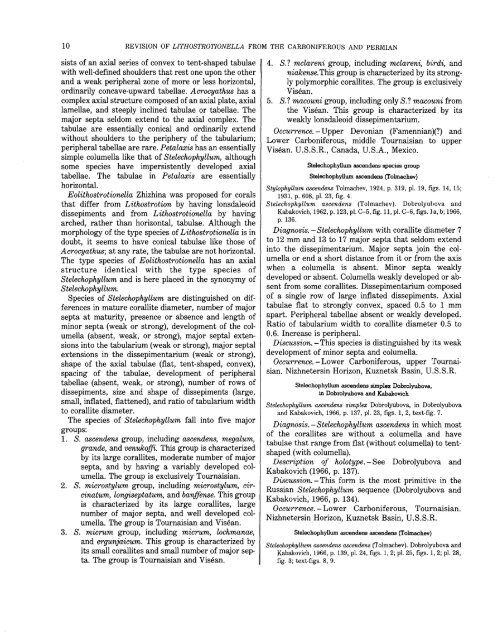Revision of Lithostrotionella - USGS
Revision of Lithostrotionella - USGS
Revision of Lithostrotionella - USGS
Create successful ePaper yourself
Turn your PDF publications into a flip-book with our unique Google optimized e-Paper software.
10 REVISION OF LITHOSTROTIONELLA FROM THE CARBONIFEROUS AND PERMIAN<br />
sists <strong>of</strong> an axial series <strong>of</strong> convex to tent-shaped tabulae<br />
with well-defined shoulders that rest one upon the other<br />
and a weak peripheral zone <strong>of</strong> more or less horizontal,<br />
ordinarily concave-upward tabellae. Acrocyathus has a<br />
complex axial structure composed <strong>of</strong> an axial plate, axial<br />
lamellae, and steeply inclined tabulae or tabellae. The<br />
major septa seldom extend to the axial complex. The<br />
tabulae are essentially conical and ordinarily extend<br />
without shoulders to the periphery <strong>of</strong> the tabularium;<br />
peripheral tabellae are rare. Petalaxis has an essentially<br />
simple columella like that <strong>of</strong> Stelechophyllum, although<br />
some species have impersistently developed axial<br />
tabellae. The tabulae in Petalaxis are essentially<br />
horizontal.<br />
Eolithostrotionella Zhizhina was proposed for corals<br />
that differ from Lithostrotion by having lonsdaleoid<br />
dissepiments and from <strong>Lithostrotionella</strong> by having<br />
arched, rather than horizontal, tabulae. Although the<br />
morphology <strong>of</strong> the type species <strong>of</strong> <strong>Lithostrotionella</strong> is in<br />
doubt, it seems to have conical tabulae like those <strong>of</strong><br />
Acrocyathus; at any rate, the tabulae are not horizontal.<br />
The type species <strong>of</strong> Eolithostrotionella has an axial<br />
structure identical with the type species <strong>of</strong><br />
Stelechophyllum and is here placed in the synonymy <strong>of</strong><br />
Stelechophyllum.<br />
Species <strong>of</strong> Stelechophyllum are distinguished on differences<br />
in mature corallite diameter, number <strong>of</strong> major<br />
septa at maturity, presence or absence and length <strong>of</strong><br />
minor septa (weak or strong), development <strong>of</strong> the columella<br />
(absent, weak, or strong), major septal extensions<br />
into the tabularium (weak or strong), major septal<br />
extensions in the dissepimentarium (weak or strong),<br />
shape <strong>of</strong> the axial tabulae (flat, tent-shaped, convex),<br />
spacing <strong>of</strong> the tabulae, development <strong>of</strong> peripheral<br />
tabellae (absent, weak, or strong), number <strong>of</strong> rows <strong>of</strong><br />
dissepiments, size and shape <strong>of</strong> dissepiments (large,<br />
small, inflated, flattened), and ratio <strong>of</strong> tabularium width<br />
to corallite diameter.<br />
The species <strong>of</strong> Stelechophyllum fall into five major<br />
groups:<br />
1. S. ascendens group, including ascendens, megalum,<br />
grande, and venuk<strong>of</strong>fi. This group is characterized<br />
by its large corallites, moderate number <strong>of</strong> major<br />
septa, and by having a variably developed columella.<br />
The group is exclusively Tournaisian.<br />
2. S. microstylum group, including microstylum, circinatum,<br />
longiseptatum, and banffense. This group<br />
is characterized by its large corallites, large<br />
number <strong>of</strong> major septa, and well developed columella.<br />
The group is Tournaisian and Visean.<br />
3. S. micrum group, including micrum, lochmanae,<br />
and ergunjaicum. This group is characterized by<br />
its small corallites and small number <strong>of</strong> major septa.<br />
The group is Tournaisian and Visean.<br />
4. S.? mclareni group, including mclareni, b'irdi, and<br />
niakense. This group is characterized by its strongly<br />
polymorphic corallites. The group is exclusively<br />
Visean.<br />
5. S.? macouni group, including only S.? macouni from<br />
the Visean. This group is characterized by its<br />
weakly lonsdaleoid dissepimentarium.<br />
Occurrence.- Upper Devonian (Famennian)(?) and<br />
Lower Carboniferous, middle Tournaisian to upper<br />
Visean. U.S.S.R., Canada, U.S.A., Mexico.<br />
Stelechophyllum ascendens species group<br />
Stelechophyllum ascendens (Tolmachev)<br />
Stylophyllum ascendens Tolmachev, 1924, p. 319, pl. 19, figs. 14, 15;<br />
1931, p. 608, pl. 23, fig. 4.<br />
Stelechophyllum ascendens (Tolmachev). Dobrolyubova and<br />
Kabakovich, 1962, p. 123, pl. C-5, fig. 11, pl. C-6, figs. la, b; 1966,<br />
p. 136.<br />
Diagnosis. - Stelechophyllum with corallite diameter 7<br />
to 12 mm and 13 to 17 major septa that seldom extend<br />
into the dissepimentarium. Major septa join the columella<br />
or end a short distance from it or from the axis<br />
when a columella is absent. Minor septa weakly<br />
developed or absent. Columella weakly developed or absent<br />
from some corallites. Dissepimentarium composed<br />
<strong>of</strong> a single row <strong>of</strong> large inflated dissepiments. Axial<br />
tabulae flat to strongly convex, spaced 0.5 to 1 mm<br />
apart. Peripheral tabellae absent or weakly developed.<br />
Ratio <strong>of</strong> tabularium width to corallite diameter 0.5 to<br />
0.6. Increase is peripheral.<br />
Discussion. -This species is distinguished by its weak<br />
development <strong>of</strong> minor septa and columella.<br />
Occurrence. -Lower Carboniferous, upper Tournaisian.<br />
Nizhnetersin Horizon, Kuznetsk Basin, U.S.S.R.<br />
Stelechophyllum ascendens simplex Dobrolyubova,<br />
in Dobrolyubova and Kabakovich<br />
Stelechophyllum ascendens simplex Dobrolyubova, in Dobrolyubova<br />
and Kabakovich, 1966, p. 137, pl. 23, figs. 1, 2, text-fig. 7.<br />
Diagnosis. -Stelechophyllum ascendens in which most<br />
<strong>of</strong> the corallites are without a columella and have<br />
tabulae that range from flat (without columella) to tentshaped<br />
(with columella).<br />
Description <strong>of</strong> holotype.- See Dobrolyubova and<br />
Kabakovich (1966, p. 137).<br />
Discussion. -This form is the most primitive in the<br />
Russian Stelechophyllum sequence (Dobrolyubova and<br />
Kabakovich; 1966, p. 134).<br />
Occurrence. -Lower Carboniferous, Tournaisian.<br />
Nizhnetersin Horizon, Kuznetsk Basin, U.S.S.R.<br />
Stelechophyllum ascendens ascendens (Tolmachev)<br />
Stelechophyllum ascendens ascendens (Tolmachev). Dobrolyubova and<br />
Kabakovich, 1966, p. 139, pl. 24, figs. 1, 2; pl. 25, figs. 1, 2; pl. 28,<br />
fig. 3; text-figs. 8; 9.

















